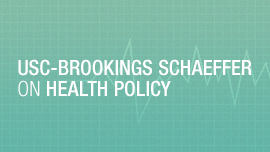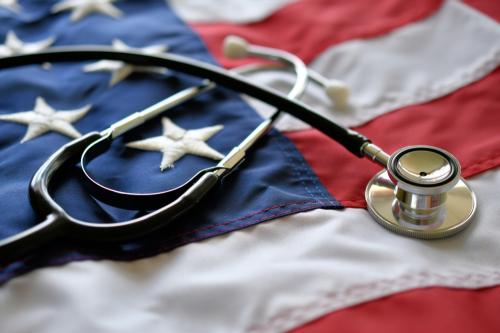This analysis is part of the USC-Brookings Schaeffer Initiative for Health Policy, which is a partnership between Economic Studies at Brookings and the University of Southern California Schaeffer Center for Health Policy & Economics. The Initiative aims to inform the national health care debate with rigorous, evidence-based analysis leading to practical recommendations using the collaborative strengths of USC and Brookings.
Too often, the systems that respond to people who are experiencing a behavioral health crisis result in a range of poor health outcomes, including mortality. They also involve people with the criminal justice system unnecessarily. Historically, behavioral health crises, which are emergencies that face people with mental health or substance use issues, have been responded to in a fragmented manner, with default reliance on law enforcement, hospitals, and jails.
Available data on the impact of these response systems on people with mental health conditions and people of color is alarming. The Washington Post’s database of police shootings and associated deaths recorded 6,800 police shootings since 2015. Twenty-three percent of police shootings and one quarter of police shooting deaths involved people with mental health conditions. The Post’s database also documents that black Americans have been killed at nearly 2.5 times the rate of white Americans, regardless of mental health status.[1]
People with serious mental illnesses (including schizophrenia, bipolar disorder and recurrent major depression) are also overrepresented in jails and prisons. Although the prevalence of serious mental illness in the general population overall is about 5%, estimates suggest that 26% of people in jails and 14% of prison inmates have a serious mental illness. [2] Although these people are incarcerated, most were involved in non-violent offenses. Incarceration rates among people of color are 1.6 to 5 times those of white populations. In addition, 2009 evidence shows that close to two thirds of people in prison or jail have substance use issues. Mental health and substance use problems frequently co-occur; and misuse of drugs or alcohol at times precipitates aggressive behavior among people with mental illnesses. [3]
Historically, few communities have put in place systems that can effectively respond to behavioral health crises, relying instead on law enforcement and the 911 system, which is often poorly prepared to address behavioral health issues. [4]
But recent interest in many communities, coupled with new policy actions and federal resources, offer the potential to expand access to evidence based treatment, including building behavioral health services that represent a crisis service continuum. [5] Evidence from community experiences suggests that these approaches can reduce arrests, incarceration, and violent interactions between people with mental illnesses and law enforcement. These policy shifts may be especially significant for low income communities of color, where rates of mental health and substance misuse conditions are high, reflecting poverty, high rates of trauma, and other adverse conditions that have a negative impact on behavioral health. [6] Behavioral health-led approaches also offer potential to reassess the role of law enforcement in responding to crisis situations involving mental illness and Substance Use Disorders.
In this blog, we describe new federal policies that are being implemented, their potential impact and implementation challenges, and identify considerations about whether additional federal policy actions are necessary to strengthen the ability of states and localities to establish behavioral health crisis services that reflect best practices to meet community needs.
Issues
Federal, state and local policies in behavioral health crisis response have been advancing incrementally for several years. One touchstone of the federal efforts is the Substance Abuse and Mental Health Services Administration (SAMHSA)’s 2020 guidelines for governments, service providers, and others involved in crisis response that define a continuum of essential crisis related services. It consists of three core components:
- Regional crisis call centers
- Mobile crisis response teams
- Crisis receiving and stabilization [7]
The SAMSHA guidelines have not been consistently adopted across the country, and in most places crisis services are significantly more fragmented and variable than these components suggest. Thus, there is likely to be substantial variation across the nation in the design and implementation of crisis continuums. Although SAMHSA’s crisis guidelines are well-known, other organizations have offered different perspectives on what the ideal behavioral health crisis system looks like, including a broader set of services and advocating for systems that are informed by people with lived experience with mental illnesses and substance use disorders (SUDs) that prioritize advancing racial equity. [8] Some have also identified a need for broader access to “upstream” behavioral health services that may help avert behavioral health crises. [9]
Recent federal policy actions have sought to advance a broader continuum of services, with an emphasis on call centers and mobile crisis. Here, we describe these recent efforts, identify the need for additional attention to other aspects of the crisis continuum, and identify ongoing financing challenges that need to be overcome to move toward a comprehensive continuum of services for people in crisis.
Strengthening initial call response for people experiencing behavioral health crises
Congress took a first step towards building more effective crisis response systems by enacting legislation in 2020 that will put into place a specialty behavioral health crisis line, 988 that is implemented at the state and local levels and will go live in July 2022. [10] 988 is intended to provide 24/7 call response, and connection to services when a person needs them. 988 builds out existing suicide prevention call response “lifelines” that have been operational in some parts of the country. We expect that the complexity of operationalizing these new services means that in practice full 988 implementation will extend well beyond July 2022. In many places, key aspects of implementation will be coordination with 911 and other call lines that are used for crisis response and ensuring appropriate service dispatch. [11]
Ensuring adequate financing both for the initial call response and connecting people who need them to services will be a key determinant of the availability and effectiveness of crisis response services. Federal law provided modest start-up money of about $35 million and allowed states to finance call center operations and services through a fee on cell carriers. [12] The Pew Charitable Trusts reports that as of October 12, four states have enacted legislation that either authorizes or imposes a surcharge on telecommunication firms to support 988. State and local governments can also finance 988 using state and local funding; California, for example, has designated $20 million in state general funds to support the new 988 crisis line. [13] In December, the Substance Abuse and Mental Health Services Administration (SAMHSA) announced that it will award $282 million in grants to support 988 implementation and that the new funding, which is a tenfold increase over the previous year’s funding level, will be distributed to crisis centers and other entities to support 988 operations, infrastructure, and staffing. [14]
Mobile crisis response teams
States and communities are also expanding access to mobile crisis response services, which can meet an individual where they are during a moment of crisis and provide immediate behavioral health services. Last year’s American Rescue Plan Act created a first-of-its-kind financial incentive for states to provide 24/7 mobile crisis services through Medicaid. The new programs, which will take effect in April, establish multidisciplinary teams made up of behavioral health professionals and can include peer support specialists, that will respond to crisis in communities and provide connections to ongoing services when needed. The federal government will finance 85 percent of state spending on these new programs via the Medicaid program. The Centers for Medicare & Medicaid Services (CMS), the federal agency responsible for the Medicaid program, awarded $15 million in planning grants last fall to 20 states to assist them in planning for implementation of the new Medicaid mobile crisis services. In December, CMS issued guidance that specifies parameters for state mobile crisis programs that qualify for the incentive and describes best practices for Medicaid-covered mobile crisis programs. [15] More than half of the states recently reported that they plan to take up the new Medicaid policy options; a few additional states are expanding Medicaid-covered mobile crisis services outside of this option. [16]
The new Medicaid mobile crisis incentive is modeled on the CAHOOTS (Crisis Assistance Helping Out on the Streets) mobile crisis intervention program in Eugene Oregon. CAHOOTS and the Eugene Police Department have reported data that suggests that CAHOOTS has responded to a significant share of 911 calls, has been able to divert some police response, and produced some savings. [17] Other mobile crisis models have also demonstrated such results. An analysis of a Connecticut youth mobile crisis program associated the program with a 25 percent reduction in emergency room use. [18] The Denver STAR program, a mobile crisis intervention that began in 2020, reports that its approach was expected to reduce police responses to calls by nearly 3 percent. [19]
Crisis receiving and stabilization
Meeting people’s behavioral health needs requires having ongoing access to services, including services that help provide stability during and after a crisis. These services include non-hospital facilities that make services available for less than 24 hours to support an individual’s well-being and recovery when needed. Ultimately, providing people access to these and other behavioral health services is likely to be as central to the success of crisis response efforts as is operationalizing immediate call response functions. A program in Tucson, Arizona is an example of how to provide stabilization to people in crisis through a crisis response center. The response center offers 24/7 walk-in services and stabilization services for up to 23 hours a day, and its services include early intervention and discharge planning. The program estimates that more than 60 percent of people who are served by the crisis response center return to the community and do not require hospitalization. [20] Finally, it is important to recognize that a complete system of treatment and support requires the availability of ongoing care that among other things reduces repeated crises. Unfortunately, many parts of the country suffer from inadequate availability of services to treat and support people after their crises. Additional investments would be important for offering a comprehensive behavioral health care system.
Although there are a wide range of ways that Medicaid can be used by states to cover and pay for these services, such initiatives have been quite limited and less federal policy activity has been devoted specifically to advancing access to these services relative to immediate crisis response. [21]
Infrastructure investments needed to build effective crisis response continuum
The experiences of states and communities show that major investments in infrastructure are required to develop crisis response capability. This includes establishing call centers, creating mobile crisis teams and building crisis receiving facilities with crisis beds. Those experiences offer some insights into the types of infrastructure investments that are required and the level of recurring expenditures for establishing and running a behavioral health crisis response system. A few lessons emerge from the receiving facility with crisis beds and stabilization services. [22] New York City built two receiving facilities for $90 million. [23] Georgia Invested $256 million to build up its overall crisis response system. [24] These experiences highlight the levels of investments that must be made to realize a crisis continuum that represent “best practices”. State and local governments generally develop non-Medicaid approaches to pay for necessary infrastructure. Given the magnitude of the investments that will be necessary nationwide, the SAMHSA block grant set aside of 5% to fund “evidence based crisis programs addressing the needs of individuals with serious mental illnesses and children with serious mental and emotional disturbances”, will fall far short on the requisite investment necessary to establish the infrastructure that supports the crisis services continuum. The ARPA legislation increased the size of the mental health block grant by $1.65- billion, which could serve as an important investment fund for states. Federal policy could promote the use of block grant funds in that way by defining all people experiencing a mental illness crisis as suffering from a serious mental illness (because many people that experience behavioral health crises would not be classified as seriously mentally ill). In addition, creating performance indicators based on the development of a crisis continuum would also serve to encourage to use the historical funding increase to support infrastructure that would support the ability to respond to calls into the forthcoming 988 crisis line.
Recurring expenditures
Operating costs for the crisis continuum are also significant. Arizona spends about $163 million per year on operation of its crisis continuum (as defined by the SAMHSA guideline noted earlier). [25] Georgia spends about $58 million on those services and Tennessee in the most recent annual report spent $45.3 million. [26] The CAHOOTS mobile crisis approach has a budget of $2.1 million that does not encompass the full continuum. [27] In Tennessee, it costs roughly $1.98 million per crisis team per year. States have relied heavily on Medicaid to pay for operating costs. Arizona relies on Medicaid to pay for 82% of the crisis system, and Tennessee uses Medicaid to pay for roughly 56% of its system.
Consider that there are 326 cities with populations of over 100,000, including 70 with populations of over 300,000 many of which have not made many investments in crisis response infrastructure nor do they have financing provisions in place to cover recurring costs. The implication is that we have a significant gap between necessary funds and our national vision for a crisis continuum that is being spurred by 988 and other policy efforts. Considering infrastructure spending alone alongside extant budget pressures we are likely to fall well short of making the investments that state and local experience suggest are required.
Medicaid has long been a leading source of coverage for crisis and other behavioral health services, and most of these services are optional for state Medicaid programs to elect. However, the need for crisis services extends well beyond Medicaid beneficiaries; many people who need behavioral health crisis services are covered by other coverage sources. Recently, there has been interest on the part of some members of Congress in expanding the role of Medicare, commercial insurers and other payers in covering crisis services. Last year, Senators Catherine Cortez Masto (D-Nevada) and John Cornyn (R-Texas) introduced the bipartisan Behavioral Health Crisis Services Expansion Act, which would significantly expand crisis service coverage and provide an ongoing source of financing for these services that goes beyond reliance on state and local funding. [28]
Observations
The creation of the 988 hotline has prompted a great deal of hope that behavioral health crises will be handled more effectively, safely and efficiently than they are in our current emergency response system. Much activity, expertise and resources are being devoted to standing up the 988-call system. Accompanying the new potential and hopes for improved care of people with crises stemming from their mental illnesses and SUDs, is the risk of not having sufficient services in place to rapidly and effectively respond to the calls that will begin to be made in July of 2022. We stand at- a once in a generation moment when there are policy opportunities, financial resources and viable models of care in place to restructure the relationships between the care of mental and addictive illnesses and law enforcement, and improve the equitable treatment of Americans who suffer from these illnesses. Doing so involves planning implementation of the 988-call line so that resources are in place that will allow communities to meet the goals of the legislation and advocacy that has brought us to this moment. This means promoting the use of new discretionary funds to build requisite infrastructure, making use of new authorities to pay for services, and expanding the coverage base so that all Americans share in the responsibility to pay for the care that will benefit them and their communities.
Finally, developing an efficient approach to constructing and financing a behavioral health crisis continuum will require data that provides visibility into existing resources, system performance, and identifies gaps in the continuum across communities in the entire nation. Significant data limitations and lack of availability of basic information must be overcome and suggest the need for additional investments throughout most of the nation.
Vikki Wachino is an advisory board member and consultant to Mental Health Strategic Impact Initiative. Other than the aforementioned, the authors did not receive financial support from any firm or person for this article or from any firm or person with a financial or political interest in this article. Other than the aforementioned, the authors are not currently an officer, director, or board member of any organization with a financial or political interest in this article.
The Brookings Institution is financed through the support of a diverse array of foundations, corporations, governments, individuals, as well as an endowment. A list of donors can be found in our annual reports published online here. The findings, interpretations, and conclusions in this report are solely those of its author(s) and are not influenced by any donation.
Footnotes:
[1] https://www.washingtonpost.com/graphics/investigations/police-shootings-database/
[2] https://bjs.ojp.gov/content/pub/pdf/imhprpji1112.pdf
[3] Steadman HJ, FC Osher, PC Robbins et al, Prevalence of serious mental illness- among jail inmates, Psychiatric Services 60:761-765, 2009.
[4] https://www.pewtrusts.org/en/research-and-analysis/issue-briefs/2021/10/new-research-suggests-911-call-centers-lack-resources-to-handle-behavioral-health-crises
[5] See for example Group for the Advancement of Psychiatry, Roadmap to the Ideal Crisis System, March 2021.
[6] https://www.scattergoodfoundation.org/publication/systemic-racial-justice-informed-solutions-to-shift-care-from-the-criminal-legal-system-to-the-mental-health-care-system/?previous=141
[7] https://store.samhsa.gov/sites/default/files/SAMHSA_Digital_Download/PEP20-08-01-001%20PDF.pdf
[8] For an alternative view on ideal crisis response systems, see, for example, https://www.thenationalcouncil.org/wp-content/uploads/2021/03/031121_GAP_Crisis-Report_Final.pdf?daf=375ateTbd56 and https://fountainhouse.org/assets/From-Harm-to-Health-2021.pdf
[9] https://fountainhouse.org/assets/From-Harm-to-Health-2021.pdf
[10] Federal Communications Commission, Implementation of the National Suicide Hotline Improvement Act of 2018, July 17, 2020. (Available at FCC-20-100A1.pdf).
[11] https://www.tacinc.org/resource/implementation-of-the-988-hotline-a-framework-for-state-and-local-systems-planning/
[12] https://www.ncsl.org/Portals/1/Documents/Health/Health_and_Human_Services_Appropriations_Provisions_Summary_FINAL.pdf
[13] https://www.pewtrusts.org/en/research-and-analysis/articles/2021/10/26/most-states-have-not-yet-acted-to-support-new-988-behavioral-health-lifeline
[14] https://www.samhsa.gov/newsroom/press-announcements/202112201100?utm_source=SAMHSA&utm_campaign=a278103bbe-SAMHSA_Announcement_2021_12_20_1600585&utm_medium=email&utm_term=0_ee1c4b138c-a278103bbe-169205190
[15] sho21008.pdf (medicaid.gov)
[16] https://www.kff.org/medicaid/issue-brief/state-policies-expanding-access-to-behavioral-health-care-in-medicaid/
[17] https://assets.foleon.com/eu-west-2/uploads-7e3kk3/41697/pdf_-_shifting_police_functions.ddfef7991278.pdf; https://www.eugene-or.gov/DocumentCenter/View/56717/CAHOOTS-Program-Analysis; https://whitebirdclinic.org/what-is-cahoots/
[18] https://www.chdi.org/publications/issue-briefs/mobile-crisis-services-effective-approach-reducing-emergency-department-utilization-among-youth-behavioral-health-conditions/
[19] https://wp-denverite.s3.amazonaws.com/wp-content/uploads/sites/4/2021/02/STAR_Pilot_6_Month_Evaluation_FINAL-REPORT.pdf
[20] Roadmap to the Ideal Crisis System: Essential Elements, Measurable Standards and Best Practices for Behavioral Health Crisis Response. Authored by the Group for the Advancement of Psychiatry. Published by the National Council for Behavioral Health. March 2021
[21] https://wellbeingtrust.org/news/how-medicaid-can-advance-mental-health-and-substance-use-crisis-response/
[22] Tucson works together, gets crisis center and system right, Behavioral Healthcare Executive, August 20, 2012
[23] https://ibo.nyc.ny.us/iboreports/detailing-the-expansion-of-behavioral-health-services-city-funded-spending-drives-new-growing-programs-under-the-mayor%E2%80%99s-thivnyc-initiative.html
[24] U.S. vs State of Georgia https://ada.gov/olmstead/documents/georgia_settle.pdf
[25] Gordon SY, Building State Capacity to Address Behavioral Health Needs Through Crisis Services and Early Intervention, Issue Brief, Milbank Memorial Fund, November 2020.
[26] See note 24 and Gordon SY, Building State Capacity to Address Behavioral Health Needs Through Crisis Services and Early Intervention, Issue Brief, Milbank Memorial Fund, November 2020.
[27] CAHOOTS Brochure 2018 available at www.eugene-or.gov/DocumentCenter/View/10635.
[28] The Behavioral Health Crisis Services Expansion Act, S1902 in the Senate. Companion legislation, HR 5611, was introduced in the House of Representatives in October.
-
Acknowledgements and disclosures
The authors would like to thank Stuart Butler for his helpful comments on this piece
The Brookings Institution is committed to quality, independence, and impact.
We are supported by a diverse array of funders. In line with our values and policies, each Brookings publication represents the sole views of its author(s).






Commentary
Building a sustainable behavioral health crisis continuum
January 6, 2022